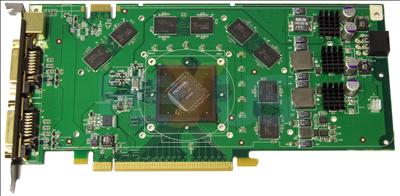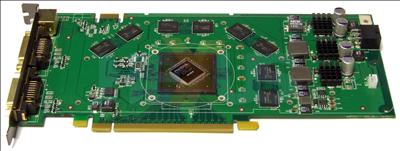What, no cooler
Basic architecture background
GeForce 9600 GT is yet another derivative of GeForce 8800 GTX (G80) technology. Based on the unified shading architecture approach that G80 brought along with it to the desktop market, the 65nm-based reference 9600 GT packs in 64 stream processors clocked in at 1,625MHz, a GPU clock of 625MHz, and, usually, GDDR3 memory operating at an effective 1,800MHz via a 256-bit bus. Compare this with, say, the £99+ GeForce 8800 GT's same-sized 112 SPs clocked in at 1,500MHz, a core speed of 600MHz, and matching memory.GeForce 9600 GT, though, is the recipient of additional per-clock performance tweaks that should help keep its performance strong, given the comparative lack of on-paper muscle.
Multimedia capabilities are given a boost with native DisplayPort and HDMI provision, although there's no on-chip audio processor/passthrough, a la Radeon HD 3800, which means that a separate cable is needed from motherboard to card if transporting HDMI out to an AV receiver is your wont.
With default-clock pricing starting at around £85, GeForce 9600 GT makes for an interesting proposition. Head on over to here for a full run-down on specifications.
Partners, however, have been encouraged to indulge in manufacturer-specific models that feature overclocked speeds and wacky cooling.
Inno3D GeForce 9600 GT ZEROtherm Hurricane
Inno3D retails six regular 9600 GT SKUs and this premium iChiLL model. Varying clocks and cooling, there's a model suited for most budgets and needs - from silence to performance.We first laid eyes on the ZEROtherm iChiLL at this year's CeBIT trade show, and here it is in retail glory.
Hold on, there's been a mistake here, right?
Yes and no, actually. The bare GeForce 9600 GT is testament to the state in which Inno3D ships the board. The ZEROtherm cooler needs to be attached by the end-user. Interesting, huh?
Kind of gives you the feeling of being short-changed, doesn't it?
We've noted the 650/1,625/1,800MHz default speeds above. The iChiLL model's BIOS is pre-programmed with overclocked frequencies of 720MHz core and 1,940MHz memory. Disappointingly, the shader clock remains the same, at 1,625MHz.
Hynix is the source for the eight DRAM modules that make up the card's 512MiB frame-buffer and knowing their 1ns rating, should overclock to well above 2,000MHz.
It feels a little strange to comment on a card without a pre-attached cooler, yet power-draw is sufficient to require a six-pin PCIe connector. If only present GPUs would function with a heatsink the size of the old Intel 486 chips. Cooling 505M transistors infers that even passively-cooled models require huge heatsinks - a sign of the times, sadly.
Part of the iChiLL specification, the rear-mounted ports are gold-plated, presumably to keep signal integrity at optimum levels for years to come. A nice touch or sheer extravagance, let us know what you think.
There's no HDMI passthrough on this model, evinced by the lack of a two-pin board-mounted header that you'd connect an S/PDIF cable to.
The seven-pin mini-DIN socket is for TV-out only, too.
Summary
We like the fact that the Inno3D iChiLL ZEROtherm ships with overclocked frequencies but are nonplussed at the lack of shader-speed enhancement and, well, HDMI connectivity.
Let's get to the cooler!














